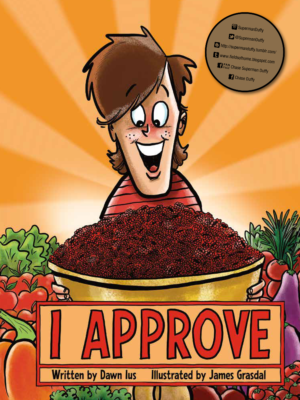
Grade 6 Learning Objectives for “I Approve”
Jump to Subject

English Language Arts
General Learning Objective
1. Students will listen, speak, read, write, view and represent to explore thoughts, ideas, feelings and experiences.
Specific Learning Objectives
1.1 Discover and Explore
Express ideas and develop understanding
- Use prior experiences with oral, print and other media texts to choose new texts that meet learning needs and interests
- Read, write, represent and talk to explore and explain connections between prior knowledge and new information in oral, print and other media texts
Experiment with language and forms
- Experiment with a variety of forms of oral, print and other media texts to discover those best suited for exploring, organizing and sharing ideas, information and experiences
1.2 Clarify and Extend
Combine ideas
- Use talk, notes, personal writing and representing, together with texts and the ideas of others, to clarify and shape understanding
- Evaluate the usefulness of new ideas, techniques and texts in terms of present understanding
General Learning Objective
2. Students will listen, speak, read, write, view and represent to comprehend and respond personally and critically to oral, print and other media texts.
Specific Learning Objectives
2.1 Use Strategies and Cues
Use prior knowledge
- Combine personal experiences and the knowledge and skills gained through previous experiences with oral, print and other media texts to understand new ideas and information
- Apply knowledge of organizational structures of oral, print and other media texts to assist with constructing and confirming meaning
Use comprehension strategies
- Identify, and explain in own words, the interrelationship of the main ideas and supporting details
- Use definitions provided in context to identify the meanings of unfamiliar words
- Monitor understanding by evaluating new ideas and information in relation to known ideas and information
Use phonics and structural analysis
- Use the meanings of prefixes and suffixes to predict the meanings of unfamiliar words in context
- Integrate and apply knowledge of phonics, sight vocabulary, language and context clues, and structural analysis to read unfamiliar words in texts of increasing length and complexity
2.2 Respond to Texts
Experience various texts
- Experience oral, print and other media texts from a variety of cultural traditions and genres, such as autobiographies, travelogues, comics, short films, myths, legends and dramatic performances
- Explain own point of view about oral, print and other media texts
- Make connections between own life and characters and ideas in oral, print and other media texts
- Discuss common topics or themes in a variety of oral, print and other media texts
- Discuss the author’s, illustrator’s, storyteller’s or filmmaker’s intention or purpose
Construct meaning from texts
- Observe and discuss aspects of human nature revealed in oral, print and other media texts, and relate them to those encountered in the community
- Summarize oral, print or other media texts, indicating the connections among events, characters and settings
- Identify or infer reasons for a character’s actions or feelings
- Make judgements and inferences related to events, characters, setting and main ideas of oral, print and other media texts
- Comment on the credibility of characters and events in oral, print and other media texts, using evidence from personal experiences and the text
Appreciate the artistry of texts
- Discuss how detail is used to enhance character, setting, action and mood in oral, print and other media texts
2.3 Understand Forms, Elements and Techniques
Understand forms and genres
- Identify key characteristics of a variety of forms or genres of oral, print and other media texts
Understand techniques and elements
- Discuss the connections among plot, setting and characters in oral, print and other media texts
- Identify first and third person narration, and discuss preferences with reference to familiar texts
- Explore techniques, such as visual imagery, sound, flashback and voice inflection, in oral, print and other media texts
General Learning Objective
3. Students will listen, speak, read, write, view and represent to manage ideas and information.
Specific Learning Objectives
3.1 Plan and Focus
Focus attention
- Distinguish among facts, supported inferences and opinions
- Use note-taking or representing to assist with understanding ideas and information, and focusing topics for investigation
Determine information needs
- Decide on and select the information needed to support a point of view
General Learning Objective
5. Students will listen, speak, read, write, view and represent to respect, support and collaborate with others.
Specific Learning Objectives
5.1 Respect Others and Strengthen Community
Appreciate diversity
- Share and discuss ideas and experiences that contribute to different responses to oral, print and other media texts

Health
Topic: Safety and Responsibility
General Learning Objective
Wellness Choices
Students will make responsible and informed choices to maintain health and to promote safety for self and others.
Specific Learning Objectives
W–6.7
- Identify and communicate values and beliefs that affect healthy choices
W–6.8
- Analyze how laws, regulations and rules contribute to health and safety practices
Topic: Learning Strategies
General Learning Objective
Life Learning Choices
Students will use resources effectively to manage and explore life roles and career opportunities and challenges
Specific Learning Objectives
L–6.3
- Analyze influences on decision making; e.g., family, peers, values, cultural beliefs, quality of information gathered

Social Studies
Topic: 6.1 Citizens Participating in Decision Making
General Learning Objective
Students will demonstrate an understanding and appreciation of the dynamic relationship between governments and citizens as they engage in the democratic process.
Specific Learning Objectives
6.1.1 recognize how individuals and governments interact and bring about change within their local and national communities:
6.1.2 Demonstrate an understanding of the fundamental principles of democracy by exploring
and reflecting upon the following questions and issues:
• What is democracy (i.e., justice, equity, freedoms, representation)? (C, PADM)
• What are the rights and responsibilities of citizens living in a representative democracy? (C, PADM)
• How does Canada’s justice system help protect your democratic and constitutional rights? (C, PADM)
6.1.4 Analyze the structure and functions of local governments in Alberta by exploring and
reflecting upon the following questions and issues:
• How are representatives chosen to form a local government (i.e., electoral process)? (PADM)
• What are the responsibilities of local governments (i.e., bylaws, taxes, services)? (PADM)
• How are local governments structured differently in rural and urban settings? (PADM)
Topic: Dimensions of Thinking
General Learning Objective
Skills and Processes
Specific Learning Objectives
6.S.1 Develop skills of critical thinking and creative thinking:
6.S.4. Demonstrate skills of decision making and problem solving: